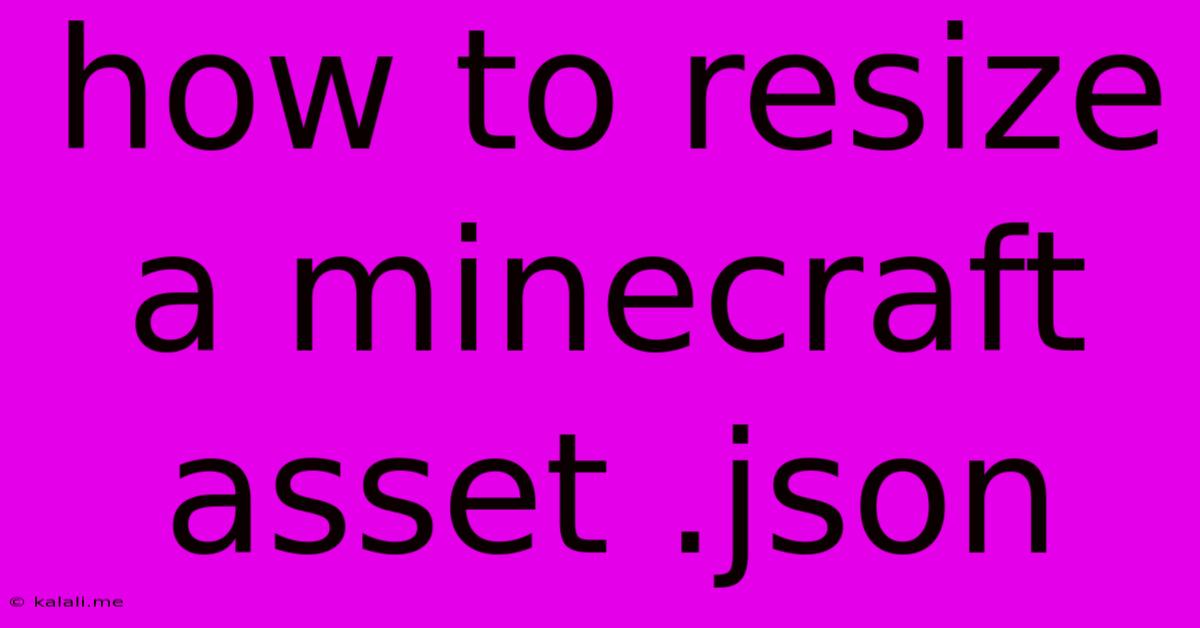How To Resize A Minecraft Asset .json
Kalali
May 29, 2025 · 3 min read

Table of Contents
How to Resize Minecraft Asset .json Files: A Comprehensive Guide
Want to tweak your Minecraft textures, but struggling with resizing your .json files? This guide provides a step-by-step approach to resizing Minecraft asset .json files, covering common issues and offering solutions for a smoother modding experience. Modifying these files allows for custom texture packs and resource packs, significantly altering the game's visual appeal. Understanding how to correctly resize these files is crucial for maintaining compatibility and visual fidelity.
Understanding Minecraft Asset .json Files
Before diving into resizing, it's crucial to grasp what these files do. Minecraft uses .json files to define the location and properties of assets within resource packs, such as textures, models, and sounds. These files contain metadata, including the file path to the actual image or model file and crucial information about its dimensions, UV mapping, and rotation. Incorrectly resizing the .json file without modifying the corresponding image file will lead to visual glitches or broken textures. Therefore, the resizing process involves adjusting both the .json file's metadata and the image file itself.
The Resizing Process: A Step-by-Step Guide
Resizing Minecraft asset .json files requires careful attention to detail. Here's a breakdown of the process:
-
Identify the Target
.jsonFile: Locate the specific.jsonfile you want to resize within your resource pack'sassetsfolder. These files are usually found within subfolders corresponding to different asset types (e.g.,textures,models). -
Backup Your Files: Always create a backup of your original
.jsonand image files before making any changes. This precaution prevents data loss if something goes wrong. -
Open the
.jsonFile: Use a text editor (like Notepad++, Sublime Text, or VS Code) to open the.jsonfile. These editors are far superior to basic text editors for handling structured files like JSON. -
Modify the
widthandheightParameters: Within the.jsonfile, locate thewidthandheightparameters. These parameters specify the dimensions of the texture or model. Change these values to reflect the new dimensions of your resized image. Remember to keep the aspect ratio consistent for optimal results. For example, if you're doubling the size, multiply bothwidthandheightby 2. -
Resize the Corresponding Image File: Use an image editing software (like GIMP or Photoshop) to resize the actual image file referenced in your
.jsonfile. Make sure to resize the image to the dimensions you specified in step 4. Using bilinear or bicubic interpolation during the resizing process will often yield superior results compared to nearest-neighbor. -
Save and Test: Save both the modified
.jsonfile and the resized image file. Then, load your resource pack into Minecraft and check if the texture or model is rendered correctly.
Common Issues and Troubleshooting
-
Texture Stretching or Compression: If your texture looks stretched or compressed, double-check that the
widthandheightvalues in the.jsonfile precisely match the dimensions of your resized image file. Any discrepancies will lead to distortion. -
Missing Textures: If the texture doesn't appear at all, verify that the file path in the
.jsonfile correctly points to the location of your resized image file. Even a minor typo can break the link. -
Incorrect UV Mapping: Advanced users might encounter issues with UV mapping, especially when significantly altering the size. UV mapping defines how the image is applied to the 3D model. Incorrect mapping leads to textures appearing in the wrong places.
-
JSON Syntax Errors: Ensure that your
.jsonfile is syntactically correct. A single misplaced bracket or comma can render the entire file unusable.
Conclusion
Resizing Minecraft asset .json files allows for extensive customization of the game's visuals. Following these steps carefully will help you achieve your desired results. Remember to always back up your files and thoroughly test your changes after making modifications. Happy modding!
Latest Posts
Latest Posts
-
Best Way To Sell Engagement Ring
May 31, 2025
-
Can You Get A Condor Lufthansa Ticket
May 31, 2025
-
Can I Tell Someone My Tip Is A Gift
May 31, 2025
-
Dragons Of Lord Of The Rings
May 31, 2025
-
How Do I Stop My Auxiliary Heat From Coming On
May 31, 2025
Related Post
Thank you for visiting our website which covers about How To Resize A Minecraft Asset .json . We hope the information provided has been useful to you. Feel free to contact us if you have any questions or need further assistance. See you next time and don't miss to bookmark.